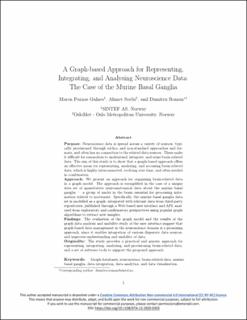| dc.contributor.author | Parnas Gulnes, Maren | |
| dc.contributor.author | Soylu, Ahmet | |
| dc.contributor.author | Roman, Dumitru | |
| dc.date.accessioned | 2022-03-18T09:27:58Z | |
| dc.date.available | 2022-03-18T09:27:58Z | |
| dc.date.created | 2021-11-12T19:39:23Z | |
| dc.date.issued | 2021-11-01 | |
| dc.identifier.citation | Data Technologies and Applications. 2021, . | en_US |
| dc.identifier.issn | 2514-9288 | |
| dc.identifier.uri | https://hdl.handle.net/11250/2986100 | |
| dc.description.abstract | Purpose: Neuroscience data is spread across a variety of sources, typically provisioned through ad-hoc and non-standard approaches and formats, and often has no connection to the related data sources. These make it difficult for researchers to understand, integrate, and reuse brain-related data. The aim of this study is to show that a graph-based approach offers an effective mean for representing, analysing, and accessing brain-related data, which is highly interconnected, evolving over time, and often needed in combination.
Approach: We present an approach for organising brain-related data in a graph model. The approach is exemplified in the case of a unique data set of quantitative neuroanatomical data about the murine basal ganglia — a group of nuclei in the brain essential for processing information related to movement. Specifically, the murine basal ganglia data set is modelled as a graph, integrated with relevant data from third-party repositories, published through a Web-based user interface and API, analysed from exploratory and confirmatory perspectives using popular graph algorithms to extract new insights.
Findings: The evaluation of the graph model and the results of the graph data analysis and usability study of the user interface suggest that graph-based data management in the neuroscience domain is a promising approach, since it enables integration of various disparate data sources, and improves understanding and usability of data.
Originality: The study provides a practical and generic approach for representing, integrating, analysing, and provisioning brain-related data, and a set of software tools to support the proposed approach. | en_US |
| dc.description.sponsorship | This work was partly funded by the EC H2020 DataCloud project (Grant number 101016835). | en_US |
| dc.language.iso | eng | en_US |
| dc.publisher | Emerald | en_US |
| dc.relation.ispartofseries | Data Technologies and Applications; | |
| dc.rights | Navngivelse-Ikkekommersiell 4.0 Internasjonal | * |
| dc.rights.uri | http://creativecommons.org/licenses/by-nc/4.0/deed.no | * |
| dc.subject | Graph databases | en_US |
| dc.subject | Neuroscience | en_US |
| dc.subject | Brain-related data | en_US |
| dc.subject | Murine basal ganglia | en_US |
| dc.subject | Data integration | en_US |
| dc.subject | Data analytics | en_US |
| dc.title | A graph-based approach for representing, integrating and analysing neuroscience data: the case of the murine basal ganglia | en_US |
| dc.type | Peer reviewed | en_US |
| dc.type | Journal article | en_US |
| dc.description.version | acceptedVersion | en_US |
| cristin.ispublished | true | |
| cristin.fulltext | postprint | |
| dc.identifier.doi | https://doi.org/10.1108/DTA-12-2020-0303 | |
| dc.identifier.cristin | 1954226 | |
| dc.source.journal | Data Technologies and Applications | en_US |
| dc.source.pagenumber | 31 | en_US |
| dc.relation.project | Horisont 2020: EC/H2020/101016835 | en_US |

